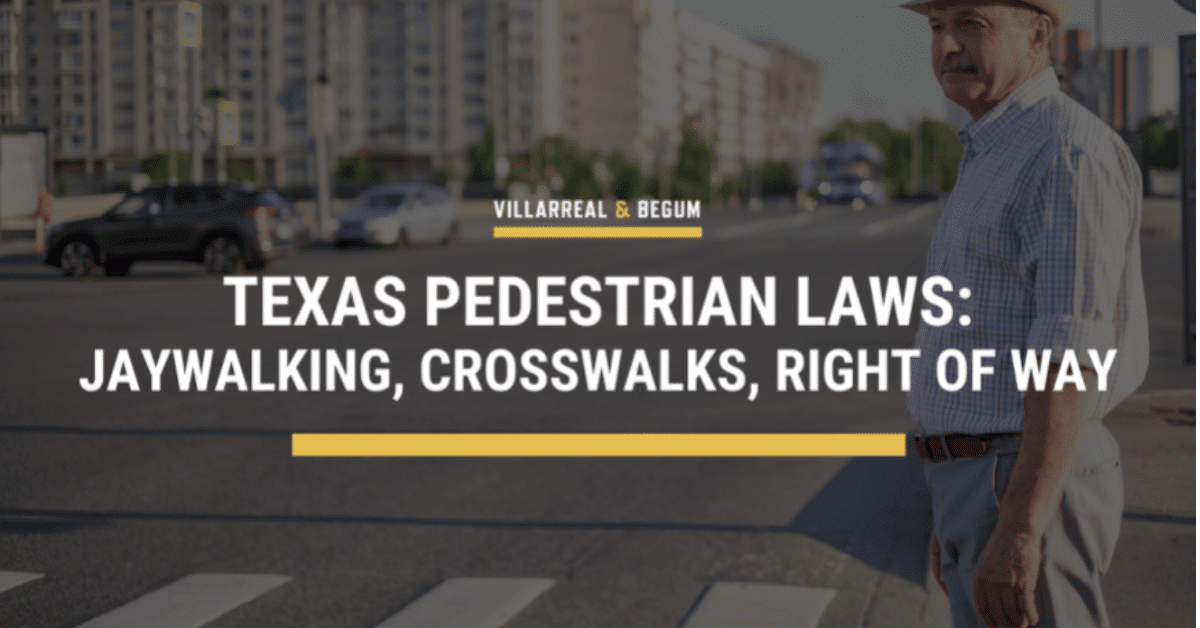There’s a common assumption that pedestrians in Texas always have the right of way, whether they’ve got the ‘walk’ signal at an intersection or are running midway across the street to save time. While it’s true that motorists are required to always look out for those traveling on foot, there are still laws both pedestrians and motorists must to help prevent pedestrian accidents.
The laws surrounding jaywalking, crosswalks, and the right of way are designed to keep everyone safe, but they can be nuanced and are often misunderstood. In this article, we’ll go over the key aspects of Texas pedestrian laws, including what constitutes jaywalking, the rules for crosswalks, and how the right of way works.
Jaywalking in Texas: What You Need to Know
In Texas, jaywalking occurs when a pedestrian crosses a street at a location without a crosswalk or against traffic signals at a crosswalk. This includes crossing mid-block, a practice known as “mid-block crossing,” or stepping into the street against a red light or a “Don’t Walk” signal.
While jaywalking might seem like a minor offense, it can lead to fines and, more importantly, put you at significant risk of being hit by a vehicle. Texas law clearly states that pedestrians must yield to motor vehicles when crossing outside of crosswalks. If a pedestrian is hit while jaywalking, they may be held liable for the traffic accident, particularly if the driver was following the rules of the road.
Crosswalks: Rules and Regulations
Crosswalks are designed to give pedestrians a safe space to cross the street. They are usually marked by painted lines and may be regulated by traffic lights or pedestrian signals. Understanding how crosswalks work and when pedestrians have the right of way can help prevent accidents and ensure smooth interactions between walkers and drivers.
Different types of crosswalks in Texas in Texas include:
- Marked Crosswalks: Marked crosswalks are easily identifiable by their painted lines on the pavement. They are commonly found at intersections and may be accompanied by pedestrian signals that indicate when it’s safe to cross. Drivers should always be on the lookout for pedestrians at these crosswalks and be prepared to stop.
- Unmarked Crosswalks: Even if there aren’t any painted lines, intersections without marked crosswalks still legally serve as crosswalks. These “implied” walkways extend the sidewalk across the road at an intersection, giving pedestrians a legal right to cross. Drivers must yield to pedestrians in these areas, even if there’s no visible crosswalk.
- Controlled Crosswalks: Controlled crosswalks have traffic control signals or pedestrian lights that regulate when pedestrians can cross. Pedestrians should follow these signals and only cross when the light is green or when the “Walk” sign is illuminated. Crossing against the signal is not only illegal but also increases the risk of accidents.
- Uncontrolled Crosswalks: In areas without traffic lights, crosswalks may be uncontrolled. Here, drivers are required to yield to pedestrians, but pedestrians should still exercise caution before stepping into a busy street. Always make sure that drivers see you and are slowing down before crossing.
Pedestrian Right of Way at Crosswalks
Pedestrians generally have the right of way at crosswalks, but there are specific rules to keep in mind:
- At intersections with traffic lights, pedestrians must wait for the “Walk” signal before crossing. If the light is red or the signal says “Don’t Walk,” they should not step off the curb. Drivers must yield to pedestrians who are already in the crosswalk when the light changes.
- Drivers must yield to pedestrians at uncontrolled intersections. However, pedestrians should avoid stepping into the crosswalk if a vehicle is too close to stop safely. Mutual respect between drivers and pedestrians is key in these situations.
- When turning at an intersection, drivers must yield to pedestrians crossing the street, even if they’re in an unmarked crosswalk. It’s essential for drivers to be vigilant and for pedestrians to stay alert, particularly at busy intersections.
Pedestrians have the right of way in many cases, but they must also ensure they are crossing safely. This means not stepping into traffic if there isn’t enough time for a vehicle to stop or if the pedestrian signal is not in their favor.
The Right of Way: Who Goes First?
Texas traffic laws give pedestrians the right of way in most situations. However, there are instances where they must yield to vehicles:
- Crossing Mid-Block: If a pedestrian crosses the street outside of a crosswalk, they must yield to vehicles. Drivers are not required to stop for those crossing mid-block, and pedestrians could be held liable if an accident occurs.
- Pedestrian Signals: At intersections with traffic lights, pedestrians must follow the signals. If the pedestrian light shows “Don’t Walk,” pedestrians must wait until it changes before crossing. Drivers must yield to pedestrians who are still crossing when the signal changes.
In areas with high pedestrian traffic, like school zones and neighborhoods, drivers must be extra cautious. Even without a crosswalk, they should be prepared to stop for pedestrians, especially children.
Additional Texas Pedestrian Laws
While most people are familiar with the basic rules for crossing the street, there are additional laws in Texas that both pedestrians and drivers should know.
- According to Texas law, if there’s a sidewalk available, pedestrians are required to use it. Walking on the roadway is prohibited if there’s a sidewalk nearby. This rule is in place to keep pedestrians safe and to reduce the likelihood of accidents.
- If there’s no sidewalk, pedestrians should walk on the left side of the road or on the shoulder, facing oncoming traffic. This positioning allows pedestrians to see oncoming vehicles and take evasive action if necessary, helping to prevent accidents.
- Local laws can also influence pedestrian rights. Municipalities in Texas have the authority to establish pedestrian-only zones, regulate pedestrian traffic in busy areas, or even restrict pedestrian access on certain roads for safety reasons. Pedestrians should be aware of any local rules that might affect where and how they can walk.
- Texas law provides specific protections for blind persons. Anyone using a white cane or a guide dog has the right of way, and drivers are required to stop and allow them to cross safely. Ignoring this law is not only illegal but also dangerous, as it puts visually impaired individuals at significant risk.
- Pedestrians are generally not allowed to solicit rides, employment, or donations from vehicles on public roads. There are exceptions, especially for charitable organizations with the proper permits, but these activities are mostly restricted to ensure traffic safety and smooth flow.
What is House Bill 1277?
House Bill 1277, passed in Texas during the 2023 legislative session, addresses pedestrian safety, particularly when sidewalks are obstructed or unsafe. Under these circumstances, pedestrians are permitted to walk on roadways facing oncoming traffic. This change is important because it provides clarity on what pedestrians should do when sidewalks are unavailable, improving safety measures across the state. The law officially took effect on September 1, 2023, and repeals previous restrictions that limited pedestrian movement in such situations.
What to Do After a Pedestrian Accident
Despite the laws in place, accidents involving pedestrians do happen. If you’re hit by a vehicle while traveling on foot, take the following steps to ensure your well-being and protect evidence for a future lawsuit.
- Get to Safety: If possible, move to a safe location and seek medical attention immediately. Even if your injuries seem minor, it’s important to have them checked by a healthcare professional.
- Report the Incident: Contact law enforcement and report the accident. An official record of the crash can serve as important evidence in any legal actions that may follow.
- Gather Information: If you’re able, collect details about the driver, the vehicle, and any witnesses. This should include names, contact information, license plate numbers, and insurance details.
- Document the Scene: Take photos or videos of the accident scene, your injuries, and any damage to the vehicle. This evidence can be critical if you decide to pursue a pedestrian injury claim.
- Keep a Record: Maintain detailed records of your medical treatments, expenses, and any other costs related to the accident. This will support your case if you seek financial compensation.
- Consult with a Personal Injury Attorney: If a medical examination confirms that you have compensable injuries, schedule a free consultation with a Texas pedestrian accident lawyer who can review your case, assign a value to your claim, and demand maximum compensation for your losses which may include medical bills, lost wages, pain and suffering, and more.
Questions? Speak to a Texas Pedestrian Accident Attorney Today
By following the rules for jaywalking, crosswalks, and the right of way, you can help prevent accidents and protect yourself and others on the road. However, collisions can occur even when you take appropriate precautions, so if you or someone you love has been injured in a pedestrian accident, it’s important to get strong legal representation.
At the Villarreal & Begum, LAW GUNS, we have helped many injured clients like you. Using our extensive experience in handling pedestrian injury cases, we will prepare a compelling case and fight for the compensation you deserve. Call our law firm at (210) 800-0000 or contact us online to schedule a free consultation and get started.
RELATED:
- Can a Pedestrian Sue if Hit by a Car in Texas?
- What is the Average Pedestrian Accident Settlement in Texas?

Alexander Begum has tried over 50 trials to verdict and tried or settled over $500 million in cases. Alex is a founding shareholder of the Texas Law Gun, Injury and Accident Lawyers.




